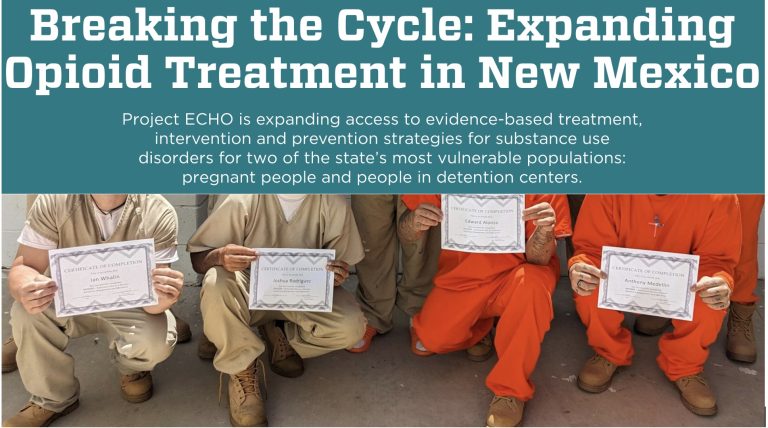OPIOID CRISIS, NEW MEXICO: OVERDOSE DEATHS DROP … THEN WITH MEDICAL TREATMENT EXPANSION PREDICTABLY SURGE
In New Mexico as consistently elsewhere, desperate naloxone campaigns struggle to keep pace with the lethality of expert gold standard treatments
by Clark Miller
Published October 31, 2025
Consistent with widespread, multiple valid measures of a worsening opioid crisis, several northern counties in New Mexico including one of the most populous have surged this year in opioid overdose deaths. Most of those deaths involve fentanyl.
A second valid measure that includes nonfatal overdoses points also to a worsening crisis – emergency department (ED) overdose-related visits.
New Mexico health officials say drug overdoses typically involve more than one substance, but fentanyl use was linked to the majority of the rising overdose deaths in three NM counties in the first half of 2025.
Compared to the first quarter of last year, drug overdoses — primarily ones involving fentanyl — caused overdose deaths to rise by 340% in Taos County; 104% in Santa Fe County and 48% in Rio Arriba County, New Mexico officials reported on Thursday.
“These are alarming figures,” NMDOH Harm Reduction Section Manager David Daniels confirmed to Source NM. The data compares shows “this huge increase within these three counties.”
According to a news release, drug overdose-related emergency department visits also increased by 206%, 131% and 81%, respectively, in the three counties. Provisional data from the state health department shows the highest number of drug overdoses occurred among people ages 35 to 44 in Taos and Santa Fe counties; in Rio Arriba County, it was people 55 to 64 years old.
[emphasis added]
Also reported in that piece, [NMDOH Harm Reduction Section Manager David] Daniels added that,
“Even before the data showed the surge in overdoses, Daniels said, the department was hearing reports from emergency rooms and from its harm reduction partners.”
Reasons for concerns for a persistently worsening crises are much broader than as revealed by its course in a few counties.
As noted in another recent New Mexico news piece –
New Mexico has been especially hard hit by the opioid crisis. In 2023, the most recent data available, the state had the seventh highest overdose rate in the U.S. While overdoses overall in the state have been declining since 2021, a recent state legislative analysis notes lack of evidence “that use of fentanyl or other opioids has also decreased.” Rather, the decline is attributable to increased use of harm-reduction medication such as Narcan to counter overdoses.
[emphasis added]
That’s remarkable. Somebody gets it,
gets that consistently, across the nation in diverse states and locales, the same tragic and criminally negligent debacle is playing out. Media stooges are assisting America’s top experts in celebrating gains against their decades-long opioid crisis that are not actually gains, instead represent persistently heightening high-risk opioid use due to expert gold standard treatment failure, increasingly but not consistently hidden by compensating effects of intensive, targeted, successful naloxone campaigns that are the equivalent of the AED (automated external defibrillator) for heart disease: not treatment and not representing gains against a surging public health problem, instead required as emergency measures precisely due to medical and public health systems failures to respond to the illness.
What about in New Mexico? What’s been going on there?
From this recent (July 2025) report from the New Mexico Legislative Finance Committee –
The state began offering medication-assisted treatment (MAT) through more than 30 public health offices in May 2024 to increase access for the population most likely to benefit. Offering MAT is consistent with the department’s practice of reducing harm from substance use, promoting healthy behaviors, and supporting justice-involved individuals.
That’s recent, and right before the reversal of a decline in opioid OD deaths in the counties reported on, and the beginning of an upward surge in OD deaths, as our graphic above illustrates.
While the precise causes of these improvements merit further study, a National Public Radio investigation indicated the likely reason is the broader availability of harm reduction tools, such as naloxone (Narcan). While fewer deaths are laudable, this heightens the need for recovery services for those who have survived but require treatment.
That’s right, it’s established that consistently, any and all recent drops in opioid OD deaths are attributable directly to naloxone campaigns, alternative rationales ruled out.
As described in the report, New Mexico’s efforts to get more doctor-dispensed substitute opioids into the hands of high-risk opioid users, including buprenorphine, the common street currency for fentanyl, have been recent, just ahead of the surge in opioid OD deaths.
Medicaid managed care organization and fee-for-service data from 2024 show that approximately 10.5 thousand people in New Mexico received MAT, …
New Mexico launched seven certified community behavioral health clinics (CCBHCs) in January 2025. The clinics will be aimed at expanding mental health and substance abuse treatment, including MAT …
In addition to public health offices, the state has recently begun providing MAT to those in need in prisons, with plans in place to also provide MAT to individuals with SUDs upon release.
In addition to the intensive efforts to dispense to high-risk opioid users the medical opioids established as fueling the crisis, buprenorphine and methadone, New Mexico followed most states in relaxing prescribing and safety standards for extra effects.

From the same report –
Most public health offices lack staff dedicated to MAT provision, and most offices rely on telehealth to connect patients with clinicians. Because public health offices provide a range of services to their communities, staff have had to adapt and pivot to provide MAT. Supporting MAT is a relatively new function that adds responsibilities to the work of existing public health office staff. The provision of MAT in public health offices relies heavily on the use of telemedicine, including doctors and other prescribers who work with patients across the state.
Approximately 23 percent of MAT visits in public health offices were telehealth visits with clinicians. More than half of the offices that have provided MAT did so exclusively through telemedicine. Out of the total of 2,141 visits for MAT from the start of FY24 through March 2025, 490 were telehealth visits.

Here’s what Quest Analytics found from doctors using telehealth over COVID years.

And here is a celebratory piece out of the University of New Mexico, published in early 2025 and highlighting expansion of jail MAT programs that, based on consistent evidence from the same programs in other locales, predict failure, overdose, and deaths.
New Mexico, with signs of a persistently worsening crisis, is far from an outlier.
We saw the same pattern in neighboring Arizona some years ago. And for the same reasons.
And in national opioid overdose “capital” Baltimore, where intensely successful implementation of American Medicine’s gold standard opioid treatments has provided predictably lethal results.
Not an outlier, despite the best efforts of a medical/media collusion to mystify and cover the lethality of a worsening epidemic. Instead of an outlier, entirely within the consistent exposure of widespread, multiple valid measures of a worsening opioid crisis, including nonfatal overdose, incidence of opioid injection-related infectious disease, also random drug screens in workplaces, persistent surge in diagnoses of opioid use disorder, and the necessity of desperate, intensive naloxone campaigns as harm reduction against failed, lethal gold standard medical treatment.










